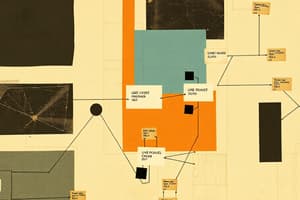Podcast
Questions and Answers
What is the primary purpose of a Use Case Diagram?
What is the primary purpose of a Use Case Diagram?
- To provide a detailed view of the system's internal workings
- To document the system's requirements in text format
- To represent the interaction between actors and a system (correct)
- To illustrate the relationships between different parts of the system
What are actors in a Use Case Diagram?
What are actors in a Use Case Diagram?
- Different states of the system
- Events that trigger system actions
- Internal entities that make up the system
- External entities that interact with the system (correct)
What role do use cases play in a Use Case Diagram?
What role do use cases play in a Use Case Diagram?
- They represent the physical components of the system
- They illustrate the flow of data within the system
- They depict specific things the system can do (correct)
- They show the hierarchy of system functions
How does a Use Case Diagram aid in the communication between stakeholders?
How does a Use Case Diagram aid in the communication between stakeholders?
How does a Use Case Diagram guide the development process?
How does a Use Case Diagram guide the development process?
What does an Association Relationship in a Use Case Diagram represent?
What does an Association Relationship in a Use Case Diagram represent?
What does the Include Relationship in a Use Case Diagram indicate?
What does the Include Relationship in a Use Case Diagram indicate?
What does the Generalization Relationship in a Use Case Diagram establish?
What does the Generalization Relationship in a Use Case Diagram establish?
What is the purpose of the system boundary in a Use Case Diagram?
What is the purpose of the system boundary in a Use Case Diagram?
What is the first step in drawing a Use Case diagram in UML?
What is the first step in drawing a Use Case diagram in UML?
Study Notes
What is a Use Case Diagram?
- A Use Case Diagram is a type of UML diagram that represents the interaction between actors and a system to accomplish specific goals.
- It provides a high-level view of the system's functionality by illustrating the various ways users can interact with it.
Use Case Diagram Notations
- UML notations provide a visual language that enables software developers, designers, and other stakeholders to communicate and document system designs, architectures, and behaviors in a consistent and understandable manner.
Actors
- Actors are external entities that interact with the system, including users, other systems, or hardware devices.
- Actors initiate use cases and receive the outcomes.
- Proper identification and understanding of actors are crucial for accurately modeling system behavior.
Use Cases
- Use cases represent specific things a system can do, like scenes in a play.
- Examples of use cases include "Place Order," "Track Delivery," or "Update Product Information."
- Use cases are represented by ovals.
System Boundary
- The system boundary is a visual representation of the scope or limits of the system being modeled.
- It defines what is inside the system and what is outside.
- The system boundary helps to establish a clear distinction between the elements that are part of the system and those that are external to it.
- The system boundary is typically represented by a rectangular box that surrounds all the use cases of the system.
Use Case Diagram Relationships
- Relationships play a crucial role in depicting the interactions between actors and use cases in a Use Case Diagram.
- These relationships provide a comprehensive view of the system's functionality and its various scenarios.
Types of Relationships
- Association Relationship: represents a communication or interaction between an actor and a use case (e.g., online banking system).
- Include Relationship: indicates that a use case includes the functionality of another use case (e.g., social media posting).
- Extend Relationship: illustrates that a use case can be extended by another use case under specific conditions (e.g., flight booking system).
- Generalization Relationship: establishes an "is-a" connection between two use cases, indicating that one use case is a specialized version of another (e.g., vehicle rental system).
Drawing a Use Case Diagram in UML
- Step 1: Identify Actors - determine who or what interacts with the system.
- Step 2: Identify Use Cases - identify the main functionalities or actions the system must perform.
- Step 3: ...
Studying That Suits You
Use AI to generate personalized quizzes and flashcards to suit your learning preferences.
Description
Learn about the importance of Use Case Diagrams in system design, how they visualize user interactions, and serve as a blueprint for functional requirements. Explore the role of Use Case Diagrams in communication among stakeholders and guiding the development process.




